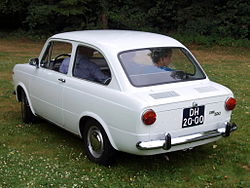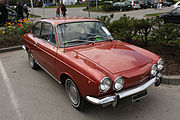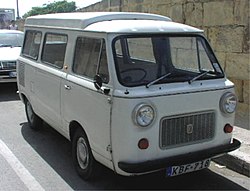Fiat 850
| Fiat | |
|---|---|
|
Fiat 850 (1964-1968)
|
|
| 850 | |
| Production period: | 1964-1973 |
| Class : | Small car |
| Body versions : | Sedan , coupe , convertible |
| Engines: |
Petrol engines : 0.84-0.9 liters (25-38 kW) |
| Length: | 3575-3820 mm |
| Width: | 1425-1500 mm |
| Height: | 1220-1385 mm |
| Wheelbase : | 2030 mm |
| Empty weight : | 670-745 kg |
| Previous model | Fiat 600 |
| successor | 127 , X1 / 9 |
The Fiat 850 is a small car with a water-cooled four - cylinder in - line engine and rear-wheel drive , which the Italian automobile manufacturer Fiat produced from summer 1964 to mid-1973. The great success of the series soon became apparent. Fiat then launched additional body variants on the same platform in the summer of 1965. In addition, numerous independent body manufacturers produced their own vehicles with the floor pan of the 850.
technical description
The model was not completely redeveloped, but an improved variant of the Fiat 600 . Although the wheelbase was only extended by 27 mm, the interior was considerably more spacious. The body, which was also extended at the front and rear, now had a notchback instead of a hatchback. The trunk in the bow was larger because of the rear-facing tank. In addition, the backrest of the rear bench seat could be folded down; this resulted in additional storage space. The rear drive set was located behind the rear axle. The 850 had the same engine as the 600, but its displacement was increased to 843 cm³ and its output to 25 kW (34 hp) with regular petrol and 27 kW (37 hp) with premium petrol. The direction of rotation of the crankshaft was now left. The driving behavior had been improved compared to the 600, although the chassis was initially largely taken over from this. Front wheels suspended from upper wishbones and a transverse leaf spring, rear wheels from trailing arms with coil springs; all wheels with telescopic shock absorbers and one anti-roll bar at the front and one at the rear. Initially, drum brakes were used on all wheels.
Body versions
limousine
The volume model was the two-door sedan with a stub tail. Depending on the engine, it reached a top speed of 121 or 126 km / h.
In March 1968, a revised version of the sedan with the designation 850 Special appeared . It had a 47 hp (35 kW) engine, front disc brakes and a sports steering wheel, and reached a top speed of 136 km / h. The special was a good sales success in Italy.
Due to its homologation in Group 1 , between 1968 and 1975 the entire participating cars of the 850 class sometimes consisted of 850 specials, namely in circuit races , hill climbs and slaloms .
Coupe
The coupé was first presented in March 1965 at the Geneva Motor Show . In order to differentiate the sporty coupé from the basic version, the engine power was increased, the equipment was expanded and adapted to the high demands. Both received sports seats, a sports steering wheel and a round speedometer. The front drum brakes were replaced by disc brakes. Initially, the coupé had an output of 47 hp (35 kW) with a displacement of 843 cm³; the maximum speed was 140 km / h.
In March 1968, Fiat revised the coupé and provided it with more powerful engines with 903 cm³ and 52 hp (38 kW) (models registered in Germany are given as 896 cm³ according to the tax formula). The car was now called the Sport Coupé . The Sport Coupé of the second series had double headlights, round double taillights and a spoiler lip at the rear. Top speed 148 km / h.
The Sport Coupé was further developed into the third series in spring 1971. The changes included four headlights of the same size with a differently designed front panel and other detailed modifications, which, however, did not look as harmonious as the second series. Instead of the imitation wood steering wheel, Fiat installed a leather steering wheel. The dashboard inserts became angular and were no longer covered with imitation wood.
Spider
At the same time as the coupé, a sporty, two-seater convertible called the Spider was presented, which could reach speeds of up to 145 km / h with its 49 hp. It was designed and built by the Bertone design studio . The fabric folding top can be completely stowed under a tailgate.
The Spider was technically further developed at the same time as the Coupé. In March 1968 it became the Sport Spider with a larger and more powerful engine . It received vertical headlights. The front bumper was raised, all bumpers got horns. The rear panel has also been changed (painted instead of polished aluminum), and a large number of minor changes are more of a technical nature. The maximum speed is 152 km / h.
The US versions of the Spider differed from the European models mainly by additional brackets on the bumpers, molded headrests on the seats, reversing lights and electrically controlled exhaust gas recirculation. German Sport Spider had a permanently installed hazard warning system with its own wiring harness.
850 T
| Fiat | |
|---|---|
|
Fiat 850 T minibus
|
|
| 850 T | |
| Manufacturer: | Fiat |
| Production period: | 1965-1976 |
| Previous model: | none |
| Successor: | Fiat 900 |
| Technical specifications | |
| Designs: | Box vans , minibuses , flatbed trucks |
| Engines: |
Petrol engines : 0.84 - 0.9 liters |
| Power: | 25 kW |
| Length: | 3804 mm |
| Width: | 1488 mm |
| Height: | 1660 mm |
The Fiat 850 T, presented in mid-1964 and produced from 1965, was a mini transporter that replaced the Fiat 600 Multipla . It was available as a Furgonetta delivery van or a minibus, which was also offered in a Familiare luxury version with double headlights. Only a few copies of the latter made it to Germany. The engine was initially taken over from the Fiat 850 N. From 1971 the 0.9-liter engine of the 850 Spider or Fiat 127 was used, whereby the power was throttled to 25 KW. However, the model name only changed to Fiat 900 a few years later .
Special bodies
Numerous Italian bodyworks used the Fiat 850 as the basis for their own sporty or elegant special versions.
One of them was the Turin-based Carrozzeria Ellena , which constructed a compact spider with a sloping front section and headlights behind a glass cover. Also Allemano created individual special versions based on the Fiat 850. Vignale produced the Fiat 850 Vignale in about 70 copies coupe and Cabriolet; the design of these structures was due to Giovanni Michelotti .
A flat two-seater is the Fiat Lombardi Grand Prix 850 , which was designed by Francis Lombardi and was derived from the 850 Coupé. In addition to a version with 850 cm³, it was also built as an Abarth Scorpione with a displacement of 1280 cm³. Almost identically constructed, the car finally came onto the market as the Otas .
production
The production of the 850 was phased out:
Initially, Fiat took the coupé out of its range in mid-1972. This was followed by the sedan (in Italy) and the Spider around mid-1973. If you add up all the variants, almost 2.3 million copies have been sold worldwide. However, Bertone continued to sell a special 850 Sport Coupé with the basic shape of the 850 Sport Spider as "Bertone Racer" until 1974 under its own direction. In Spain, Seat continued to build the 850 until 1974.
As a successor to the sedan, the Fiat 127 came on the market in spring 1971 , while there was actually no replacement for the coupé, because the Fiat 128 coupé was much larger and more expensive. In terms of model policy, the Spider was replaced by the different Fiat X1 / 9 with a mid-engine from autumn 1972 . Thanks to the fixed Targa roof, it was also a possible alternative for the 850 Coupé.
Spanish versions
In Spain, Seat manufactured all variants of the Fiat 850 under the name Seat 850 from 1966 to 1974 . In addition to the Italian program, there were also two sedan versions with four doors (Seat 850 "4 Puertas Normal" / "Largo") based on a design by the Italian body manufacturer Francis Lombardi .
Towards the end of the production time of the Seat 850, the Seat 133 was developed in Spain , which had a body in the style of the small 126 Bambino on the platform of the Fiat 850. It was also offered briefly in Germany as the Fiat 133, but there were only very small sales figures and the quality of the Spanish car was poor.
Technical specifications
| Technical data Fiat 850 | |||||||
|---|---|---|---|---|---|---|---|
| Fiat 850: | normal | great | Special | Coupe | Barchetta / Spider | Sport Coupé 903 cm³ |
Sport & Spider 903 cc |
| Engine: | 4-cylinder in-line engine (four-stroke) | ||||||
| Displacement: | 843 cc | 903 cc | |||||
| Bore × stroke: | 65 × 63.5 mm | 65 × 68 mm | |||||
| Performance at 1 / min: | 25 kW (34 hp) at 5300 |
27 kW (37 hp) at 5300 |
35 kW (47 hp) at 6200 |
36 kW (49 hp) at 6200 |
38 kW (52 hp) at 6500 |
||
| Max. Torque at 1 / min: | 56 Nm at 3200 | 57 Nm at 3400 | 61–63 Nm at 3600 | 68 Nm at 4000 | |||
| Compression: | 8.1: 1 | 8.8: 1 | 9.3: 1 | 9.5: 1 | |||
| Mixture preparation: | 1 downdraft carburetor Weber 30 ICF |
1 downdraft carburetor Weber 30 DIC1 |
1 downdraft carburetor Weber 30 DIC2 |
||||
| Valve control: | hanging valves , side camshaft, chain | ||||||
| Cooling: | Water cooling | ||||||
| Transmission: | 4-speed gearbox, stick shift 850 Idroconvert and 850 Special Idroconvert: four-speed semi-automatic (Fiat-Ferodo) |
||||||
| Front suspension: | Transverse leaf spring below, wishbone above, | ||||||
| Rear suspension: | Trailing arm axle, coil springs | ||||||
| Brakes: | Four wheel drum brakes | Disc brakes in the front, drums in the back | |||||
| Steering: | Worm steering | ||||||
| Body: | Sheet steel, self-supporting | ||||||
| Track width front / rear: | 1150/1210 mm | 1170/1220 mm | |||||
| Wheelbase: | 2030 mm | ||||||
| Dimensions: | 3575 × 1425 × 1385 mm | Coupé: 3650 × 1500 × 1300 mm Spider: 3820 × 1500 × 1220 mm |
|||||
| Empty weight: | 670 kg | 690 kg | 720-725 kg | 745 kg | |||
| Top speed: | 120 km / h | 126 km / h | 135 km / h | 135+ km / h | 145 km / h | 145+ km / h | 150 km / h |
| 0-100 km / h: | not specified | ||||||
| Consumption (liters / 100 kilometers, CUNA norm): | 6.3 N | 6.0 S. | 7.1 p | 7.0 S. | 7.1 p | 7.0 S. | 7.1 p |
Web links
- German brand club for all 850 models - Spider, Coupe, Limousine, Moretti, Lombardi, Vignale and Abarth
- Italian 850 Spider Club
- Dutch 850 Spider Club
- Driving video Spider - Coupè - Limousine - Bus
Individual evidence
- ↑ Not a thousand and yet a utility vehicle : Fiat 850. In: Motor vehicle technology . 7/1964, pp. 264-265.
- ↑ http://www.dmsb.de/downloads/1884/Homo.-Liste_historisch_ausl._Hersteller.pdf
- ↑ http://touringcarracing.net/Races/1972%20ADAC%20Karlsruhe.html
- ↑ D. Bartetzko: Family box. In Oldtimer Praxis , issue 12/2017, pp. 28–32.
- ↑ http://home.planet.nl/~fredr079/alg/images/ar004_4.jpg















